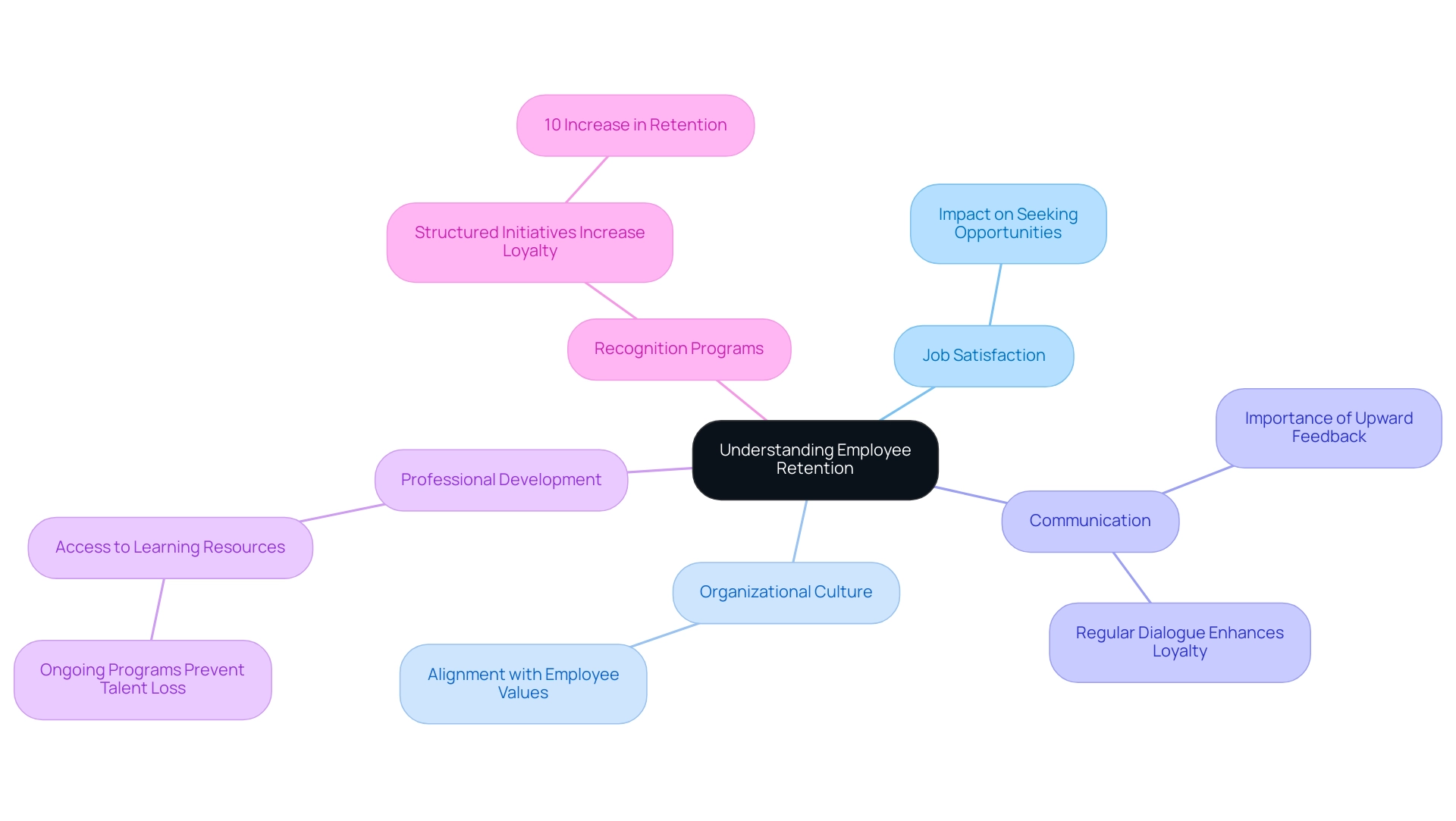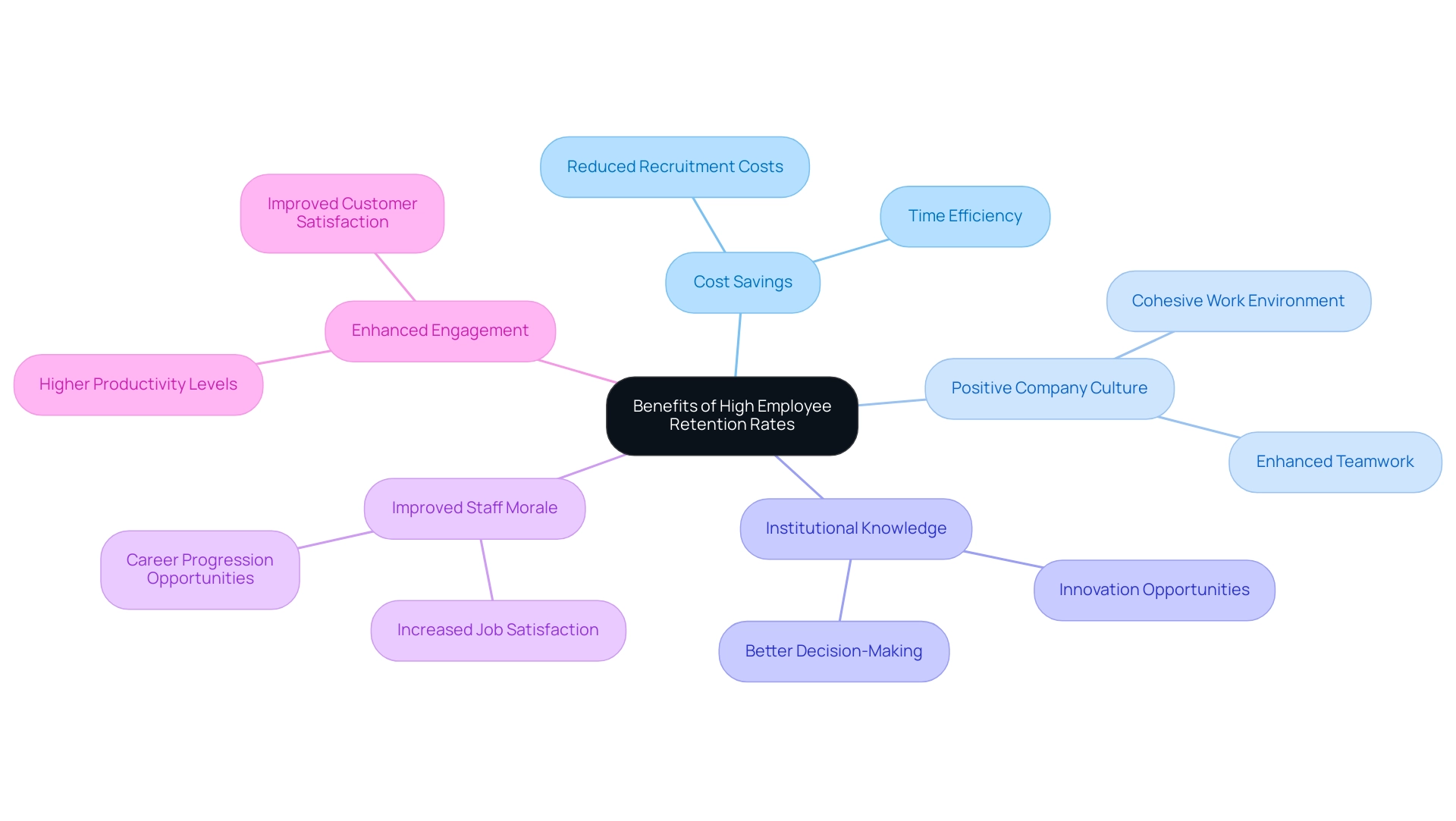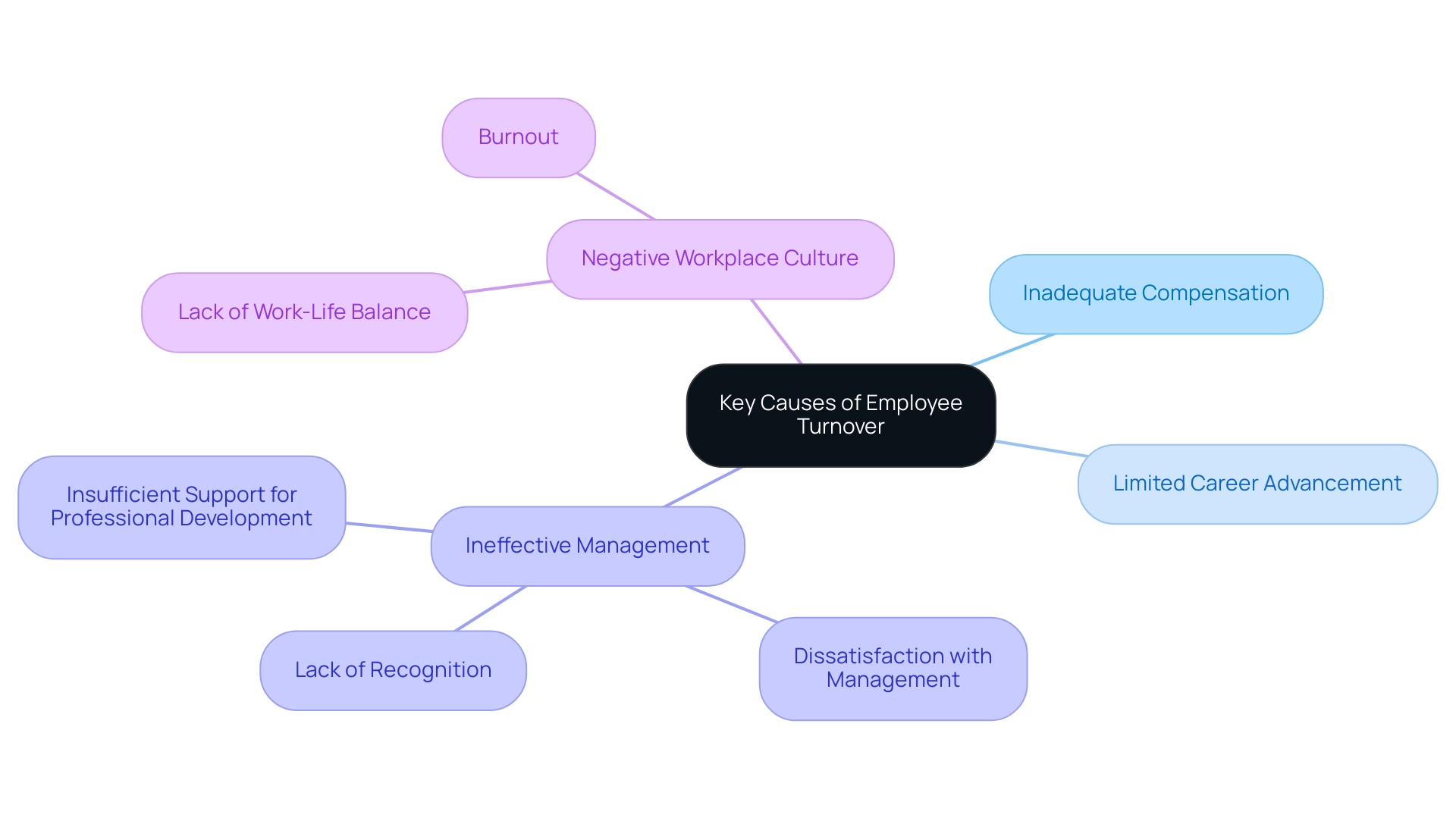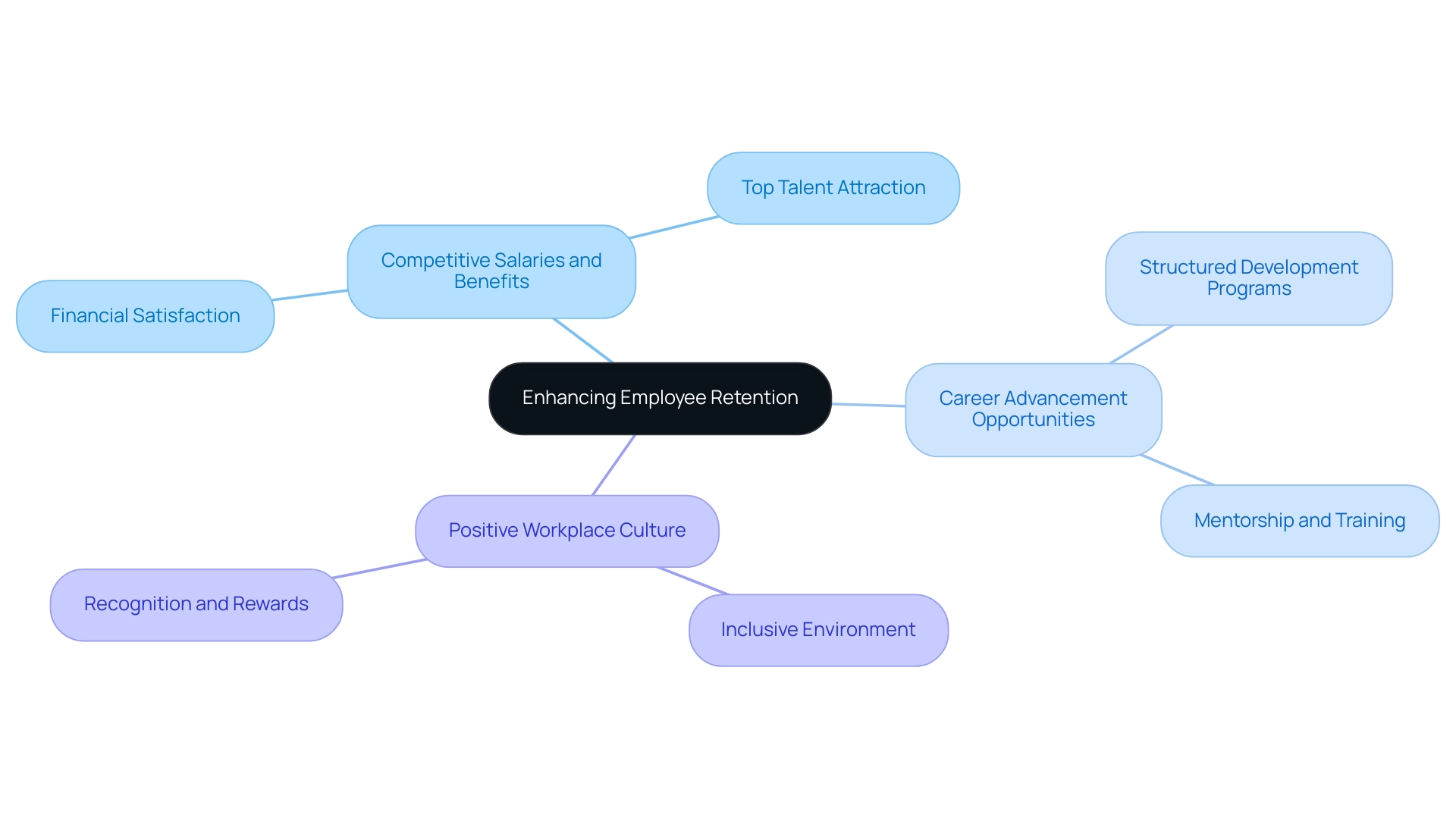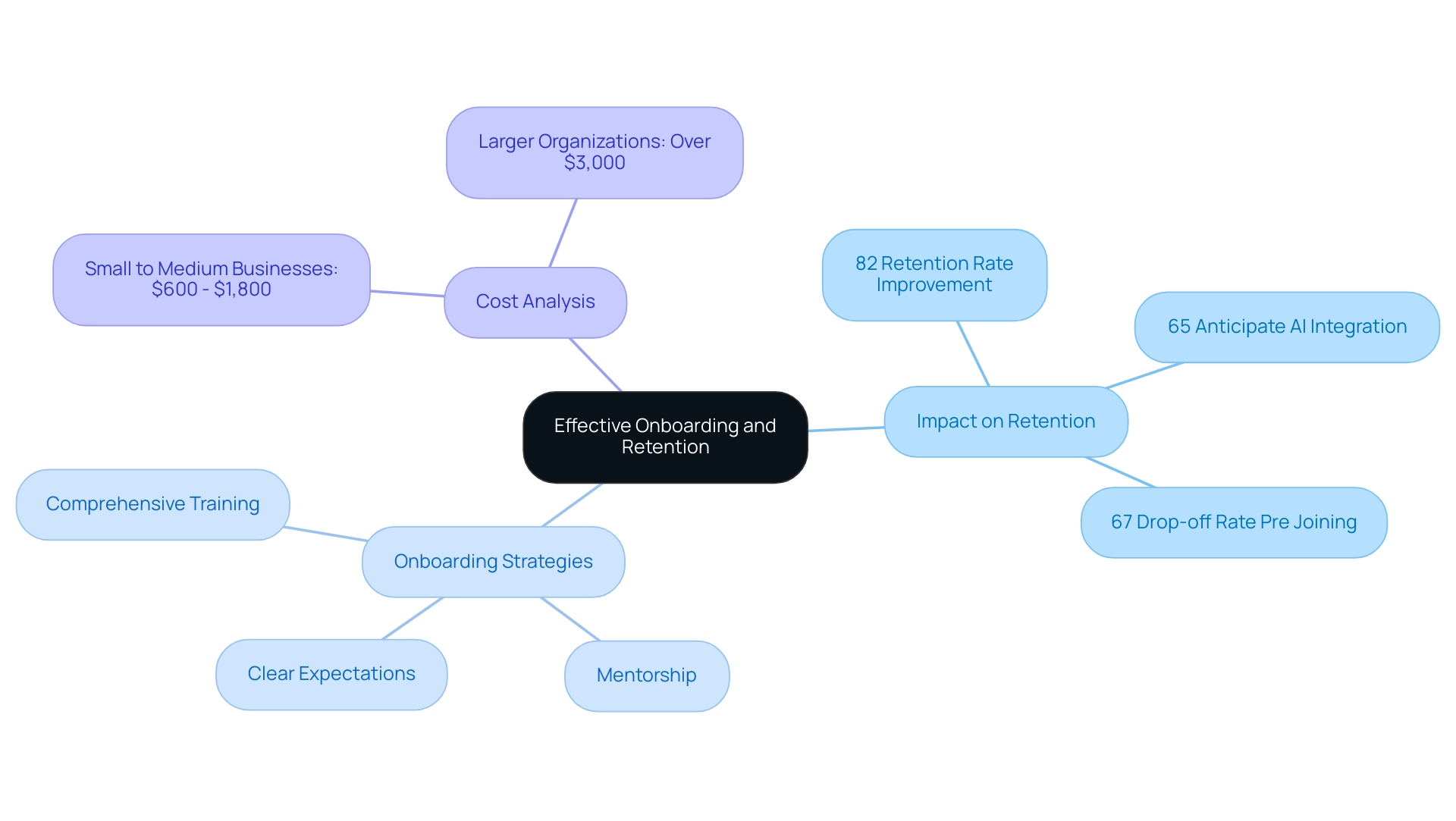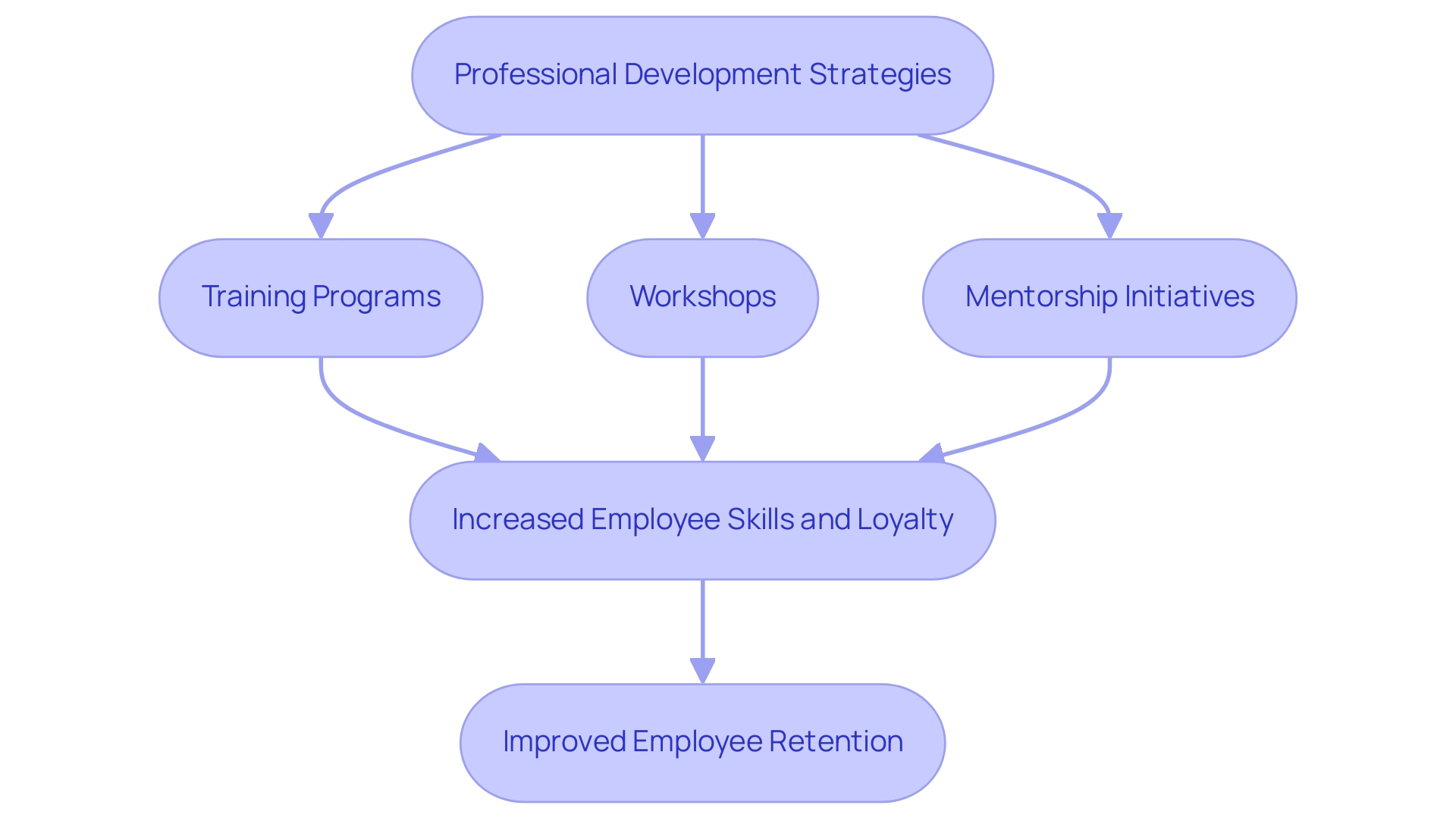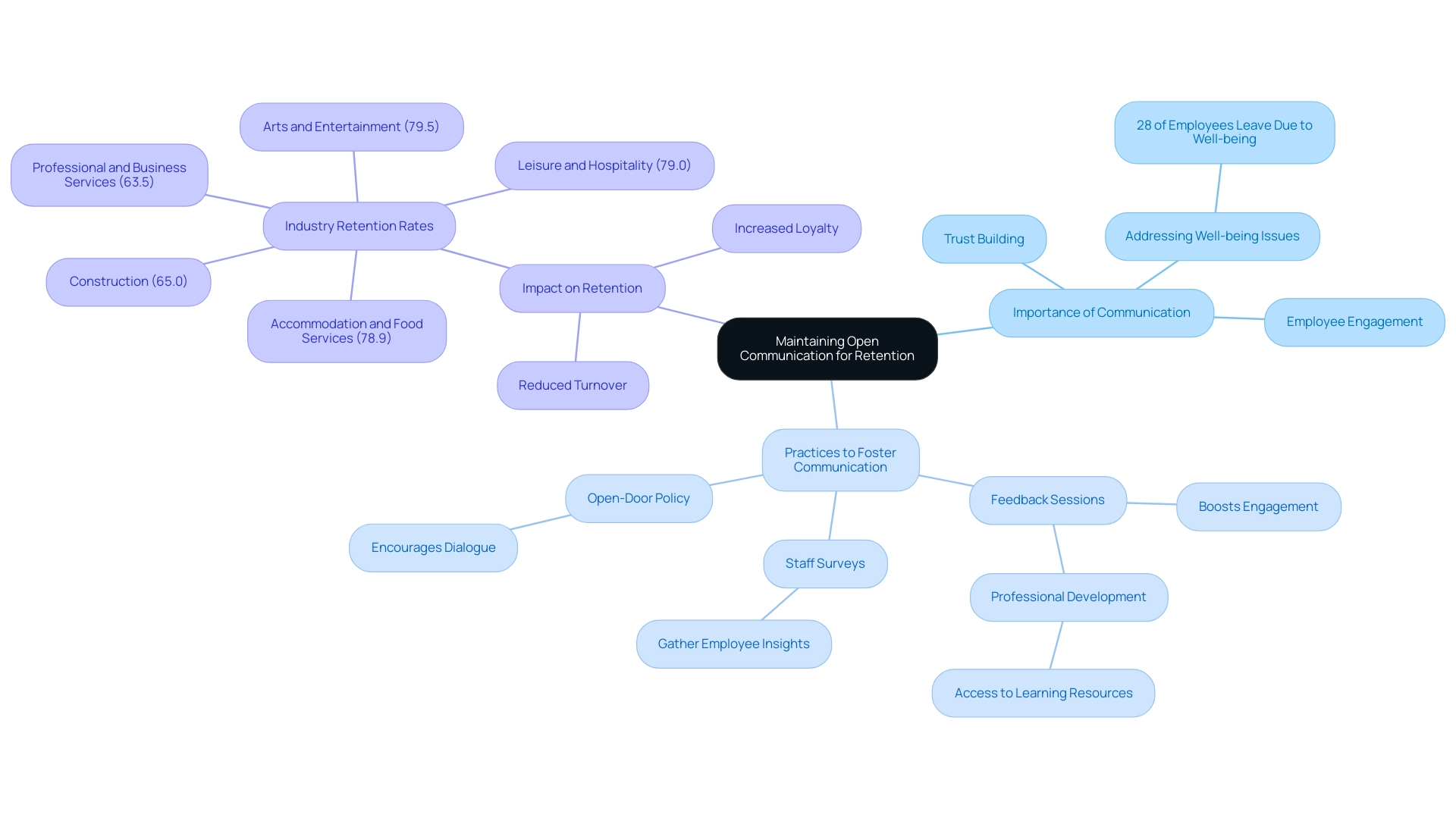Overview
Creating effective employee retention programs is crucial in addressing the challenges of workforce stability. Implementing strategies that enhance job satisfaction, professional development, and workplace culture is essential. Key components such as:
- Competitive compensation
- Structured onboarding
- Open communication
play a pivotal role in fostering an environment where employees feel valued and engaged. These elements collectively contribute to a significant reduction in turnover rates, reinforcing the necessity of a well-structured retention strategy.
Key Highlights:
- Employee retention refers to a company’s ability to maintain its workforce, fostering a stable and productive environment.
- High employee loyalty is essential for productivity and morale, with job satisfaction and organizational culture being key factors.
- Open communication and regular feedback can significantly improve employee loyalty, with studies showing a 16% decrease in retention due to lack of upward feedback.
- Ongoing professional development programs are crucial for preventing talent loss and enhancing employee capabilities.
- Companies with structured recognition initiatives can see a 10% increase in employee loyalty within a year.
- High retention rates reduce recruitment and training costs, contributing positively to the bottom line.
- Long-term employees provide valuable institutional knowledge, improving decision-making and innovation.
- Common causes of turnover include inadequate compensation, limited career advancement opportunities, and negative workplace culture.
- Effective onboarding processes can increase new hire retention rates by up to 82%.
- Organizations that prioritize professional development and career growth see improved staff loyalty and reduced turnover.
- Creating a positive workplace culture through teamwork, recognition, and open communication enhances employee satisfaction and retention.
- Implementing employee retention programs that focus on engagement, recognition, and communication is essential for fostering a loyal workforce.
Introduction
In the dynamic landscape of the modern workplace, employee retention stands as a critical concern for organizations aiming to sustain a competitive advantage. As companies confront elevated turnover rates, grasping the complexities of what fosters employee engagement and commitment has become increasingly essential.
Retention transcends mere statistics; it involves the development of a workplace culture where individuals feel valued, supported, and driven to contribute. By fostering open communication and implementing comprehensive professional development programs, organizations must navigate a multitude of strategies to bolster retention.
This article explores the multifaceted approach necessary to cultivate a loyal workforce, underscoring the significance of engagement, recognition, and effective onboarding in propelling long-term organizational success.
Understanding Employee Retention: Definition and Importance
Employee preservation is defined as a company’s ability to sustain its workforce over time, reflecting a stable and productive environment. In 2025, high employee loyalty rates are increasingly recognized as essential for maintaining productivity and morale within organizations. Retention transcends the mere act of keeping staff; it encompasses fostering an environment where individuals feel valued and engaged.
Several factors significantly influence staff retention today:
- Job satisfaction remains paramount, as individuals who find fulfillment in their roles are less likely to seek opportunities elsewhere.
- A robust organizational culture that aligns with employee values can enhance loyalty.
For example, companies prioritizing open communication and feedback have observed notable improvements in employee loyalty rates. A study revealed that a lack of upward feedback could result in a 16% decrease in retention, underscoring the necessity of regular dialogue between management and staff. This aligns with findings from the case study titled ‘Communication and Retention,’ which emphasizes the importance of maintaining open lines of communication to enhance staff satisfaction.
Moreover, ongoing professional development programs are crucial in preventing talent loss. As Ryan Bradshaw noted, “The best way to prevent this problem is by providing ongoing professional development programs so that staff members have access to learning resources as needed.” Providing access to learning materials not only enhances staff capabilities but also demonstrates a company’s commitment to their growth.
Data suggests that organizations implementing structured recognition initiatives have experienced a 10% increase in loyalty within a year, highlighting the impact of acknowledging staff contributions.
In 2025, the significance of staff loyalty is further underscored by current engagement statistics, which indicate that companies with high engagement levels experience lower turnover rates. A recent report on the state of workplace connection in 2025 reinforces these engagement statistics, emphasizing the necessity for effective strategies to retain employees. Effective employee retention programs are characterized by their ability to cultivate a supportive atmosphere, where individuals feel appreciated and motivated to contribute to the organization’s success.
By understanding and addressing these critical factors, HR managers can effectively reduce turnover and nurture a loyal workforce.
The Benefits of High Employee Retention Rates
High staff loyalty levels provide numerous benefits for companies, making them a crucial emphasis for efficient workforce management. One of the most significant benefits is the substantial reduction in recruitment and training costs. Hiring new staff can be both costly and time-consuming; therefore, keeping current talent not only saves money but also streamlines operations.
In fact, entities that prioritize staff loyalty can see cost savings that directly affect the bottom line. Moreover, a stable workforce nurtures a positive company culture, which is essential for fostering teamwork and collaboration. Employees who remain with a company for extended periods contribute to a cohesive work environment, enhancing interpersonal relationships and overall morale.
This stability enables entities to cultivate a robust sense of community, which is crucial for sustaining high levels of staff engagement.
Long-term staff members also contribute invaluable institutional knowledge. Their familiarity with company processes and culture enables better decision-making and drives innovation, as they can leverage their experience to identify opportunities for improvement. This depth of understanding is often lost when turnover rates are high, leading to disruptions in workflow and productivity.
Additionally, organizations with high retention rates typically experience improved staff morale and engagement. When staff feel valued and see opportunities for career progression, they are more likely to remain committed to their roles. Statistics indicate that individuals who perceive they are advancing in their careers are 20% more likely to remain with their companies for at least another year.
This commitment results in increased productivity levels and improved customer satisfaction, as engaged staff are more inclined to exceed expectations in their roles.
Case studies show that tackling common causes for turnover—such as inadequate management practices, absence of career advancement opportunities, and cultural misalignment—can greatly enhance loyalty rates. By proactively addressing these challenges, companies can foster a more positive work atmosphere that not only keeps talent but also draws in new candidates.
Boutique Recruiting illustrates the effectiveness of concentrating on employee loyalty, as shown by their strong history of success in sourcing high-quality talent across various industries, including positions such as Chief of Staff, Executive Assistant, and Customer Service Representative. Their customized hiring solutions guarantee that companies discover candidates who not only meet the job criteria but also resonate with the corporate culture, thus improving employee longevity. Boutique Recruiting also performs custom searches tailored to the unique needs of each organization, ensuring a perfect match for both the role and the company culture.
As Eric Eddy observes, the firm’s capability to provide top-tier candidates swiftly and effectively highlights the significance of efficient recruitment strategies in boosting staff stability.
In summary, the advantages of high workforce loyalty rates are evident: they result in cost savings, promote a positive company culture, enhance institutional knowledge, and improve overall worker morale and engagement. Investing in employee retention programs, supported by Boutique Recruiting’s customized hiring solutions, is not merely a strategic action; it is crucial for sustained organizational success. For HR managers looking to enhance their workforce management strategies, contacting Boutique Recruiting for personalized recruitment solutions can be a pivotal step towards achieving these goals.
Identifying Key Causes of Employee Turnover
Recognizing the key causes of staff turnover is essential for the development of effective employee retention programs. In 2025, common reasons for staff departures include:
- Inadequate compensation
- Limited career advancement opportunities
- Ineffective management practices
- Negative workplace culture
Additionally, factors such as burnout and a lack of work-life balance have become increasingly significant contributors to turnover rates.
Research indicates that 57% of CEOs prioritize retaining and engaging their staff, underscoring the importance of addressing these issues. As Barry Ryan, Head of Marketing, aptly states, “Losing staff is expensive.” Conducting exit interviews and staff surveys can yield valuable insights into the motivations behind departures.
For instance, organizations that have implemented structured exit interviews have successfully identified specific pain points, allowing them to proactively address concerns and improve workplace conditions.
A case study from Boutique Recruiting illustrates this approach effectively. By focusing on building lasting relationships and understanding company culture, Boutique Recruiting has been able to deliver candidates who not only meet technical qualifications but also align with the organizational environment. Their expertise in sourcing high-quality talent for technical and HR roles, as well as marketing and operational positions across diverse industries in the U.S. and Canada, has contributed to their reputation as a trusted recruiting partner.
This meticulous strategy emphasizes the significance of cultural fit in keeping talent, reinforcing the need for HR managers to comprehend the reasons individuals depart.
Moreover, HR specialists emphasize that understanding the reasons staff members depart is essential for crafting targeted interventions. Statistics reveal that common reasons for turnover include:
- Dissatisfaction with management
- Lack of recognition
- Insufficient support for professional development
By addressing these key causes, HR managers can implement tailored employee retention programs that enhance worker satisfaction and ultimately boost loyalty rates.
Boutique Recruiting’s dedication to employing exit interviews and staff feedback exemplifies how employee retention programs can effectively tackle turnover issues and cultivate a more engaged workforce.
Proven Strategies for Enhancing Employee Retention
To improve staff retention, companies can implement employee retention programs that address the fundamental causes of turnover. Providing competitive salaries and extensive benefits is crucial; in 2025, financial dissatisfaction continues to be a significant reason for workforce turnover. Companies prioritizing fair compensation not only attract top talent but also foster loyalty among existing employees.
Creating clear career advancement paths is another critical strategy. Employees are more likely to remain with a company that invests in their growth through structured development programs. Organizations such as Google and Deloitte have effectively executed strong staff development initiatives, including mentorship and training programs, greatly enhancing job satisfaction and retention figures. Boutique Recruiting, with its impressive track record of success in connecting high-quality candidates across diverse industries, including technical and HR roles, can assist organizations in developing tailored staff development programs that align with their specific needs.
Fostering a positive workplace culture is equally essential. Organizations that cultivate an inclusive and supportive environment see lower turnover rates. Consistently acknowledging and rewarding contributions from staff can further enhance this culture, making individuals feel valued and appreciated.
In fact, 57% of CEOs in 2025 rank retaining and engaging staff as a top business priority, reflecting the growing recognition of the importance of staff satisfaction. As Eric Eddy indicated, Boutique Recruiting has the capability to provide outstanding candidates swiftly and effectively, assisting businesses in creating a robust workforce that enhances a positive culture.
Furthermore, comprehending the financial effects of turnover can encourage companies to invest in strategies for keeping their employees. Replacing a staff member can cost an average of 33% of their annual salary; for a median salary of $50,000, this translates to approximately $16,500. By employing effective employee retention programs, companies can not only reduce turnover but also enhance their bottom line.
In summary, a multifaceted approach that includes competitive salaries, clear advancement opportunities, and a positive workplace culture, combined with employee retention programs focusing on recognition and development initiatives, can significantly improve employee loyalty. By prioritizing these strategies, institutions can create a more engaged and satisfied workforce. With the support of Boutique Recruiting’s personalized talent acquisition solutions across the U.S. and Canada, companies can ensure that their recruitment practices align with their retention efforts.
Contact Boutique Recruiting today to learn more about how we can help you find the right talent for your needs.
Fostering Employee Engagement and Recognition
Promoting staff engagement and recognition is essential for employee retention programs aimed at retaining top talent in today’s competitive job market. Involved staff demonstrate greater productivity and dedication to their companies, making it crucial for firms to prioritize these elements. In 2025, 57% of CEOs acknowledge staff retention and engagement as a top priority, reflecting a slight decrease from 60% in 2024, yet underscoring its ongoing significance.
To enhance engagement, entities must cultivate an atmosphere of open communication, where individuals feel empowered to share their thoughts and feedback. Involving staff in decision-making processes not only fosters a sense of ownership but also strengthens their connection to the organization. Regular check-ins and feedback sessions are vital; they help individuals feel valued and reinforce their role within the team.
Recognition programs that celebrate staff achievements—both large and small—can significantly elevate morale and job satisfaction. Research indicates that organizations implementing best practices in recognition report an average of 70% staff engagement. This engagement correlates with clear expectations, the provision of necessary tools for success, and acknowledgment of contributions.
Furthermore, the influence of acknowledgment on staff loyalty is profound. Businesses that actively recognize their staff’s efforts experience a significant enhancement in retention levels, making employee retention programs essential, as individuals are more inclined to stay with companies that value their contributions. For instance, wellness initiatives have been shown to enhance staff engagement rates, with some organizations achieving a remarkable 150% return on investment through holistic approaches to wellbeing.
Dr. Steven Aldana, founder of WellSteps, asserts, “Furthermore, our evidence-based solutions are proven to influence positive behavior change to enhance wellbeing and employer ROI.”
Additionally, it is crucial to consider the financial implications of staff turnover. On average, it costs $4,700 to recruit a new staff member, with total expenses potentially reaching three to four times the position’s salary. This highlights the financial advantages of implementing effective retention strategies.
HR specialists emphasize the significance of effective communication in promoting employee retention programs. By establishing robust feedback mechanisms and recognition strategies, organizations can create a culture that supports effective employee retention programs, driving both talent retention and productivity. Successful companies exemplify these principles, showcasing effective staff feedback and communication strategies that lead to a more engaged and committed workforce.
The Impact of Effective Onboarding on Retention
Effective onboarding is paramount for enhancing staff loyalty. A meticulously designed onboarding program not only aids new hires in acclimating to the company culture but also clarifies their roles and fosters relationships with colleagues. Research indicates that companies with robust onboarding processes can elevate new hire retention rates by as much as 82%.
To cultivate an effective onboarding experience, organizations must implement comprehensive training programs, assign mentors to guide new staff, and establish clear expectations from the outset. By prioritizing onboarding, companies can engender a sense of belonging and commitment among new hires, significantly reducing the likelihood of early turnover.
Looking ahead to 2025, nearly 65% of HR professionals anticipate that integrating AI into onboarding will positively influence employee retention. This trend underscores the necessity of adapting onboarding strategies to leverage technology effectively. Furthermore, statistics reveal that 67% of companies experience a drop-off percentage exceeding 10% before new hires even join, highlighting the critical need for enhanced onboarding practices.
As Neelie Verlinden, a digital content creator at AIHR, articulates, “67% of companies complain about more than a 10% drop-off percentage pre joining,” emphasizing the challenges organizations face in retaining candidates before they even start.
Organizations that excel in onboarding not only bolster loyalty but also set a benchmark for worker satisfaction. Boutique Recruiting’s impressive history of achievement exemplifies the efficacy of structured onboarding procedures in enhancing employee loyalty. A cost analysis of onboarding staff indicates that small to medium-sized businesses typically invest between $600 and $1,800 per individual, whereas larger organizations may allocate upwards of $3,000.
Understanding these costs is vital for effective budgeting and recognizing the financial implications of onboarding strategies. By investing in a structured onboarding process, companies can significantly enhance their employee retention programs and overall workforce management.
Providing Professional Development and Growth Opportunities
In today’s competitive job market, offering professional development and growth opportunities stands as a cornerstone of effective employee retention programs. Research reveals that individuals who perceive avenues for learning and career advancement are markedly more inclined to remain with their organization when robust retention strategies are implemented. A recent report underscores this, with 57% of CEOs identifying the retention and engagement of staff as a paramount business priority, highlighting the critical nature of this issue.
Organizations can adopt a spectrum of strategies to bolster workforce development, such as:
- Training programs
- Workshops
- Mentorship initiatives
These programs not only enhance employee skills but also foster a profound sense of loyalty among staff. For example, companies that emphasize clear career paths and engage in regular dialogues regarding professional aspirations can significantly boost commitment among their workforce.
Data from 2025 indicates that organizations with strong training initiatives and employee retention programs witness heightened staff loyalty, with preservation levels improving notably among individuals who feel supported in their career progression.
The importance of professional growth in retaining staff cannot be overstated. A Career Development Index has been established to evaluate companies based on their internal promotion rates and commitment to career advancement, providing a benchmark for organizations aiming to refine their employee retention strategies and loyalty initiatives. Furthermore, HR specialists emphasize that opportunities for career growth are vital for maintaining a motivated workforce. Implementing employee retention programs can also address the 16% decline in loyalty observed among staff hesitant to provide upward feedback, underscoring the necessity for open communication between management and personnel.
Examples of companies successfully executing mentorship programs illustrate the positive impact on workforce loyalty. These initiatives not only offer guidance but also cultivate a supportive atmosphere that encourages employees to excel. Case studies reveal that organizations investing in employee retention programs and professional development opportunities experience a notable increase in employee loyalty, reinforcing the notion that fostering a culture of growth is essential for long-term success.
By prioritizing professional development, organizations can cultivate an engaged and loyal workforce, ultimately propelling their success within the industry.
Building a Positive Workplace Culture for Retention
Creating a positive workplace culture is essential for the success of employee retention programs. A supportive and inclusive environment not only fosters engagement but also significantly boosts staff satisfaction. Research indicates that 57% of CEOs prioritize retaining and engaging staff as a top business goal in 2025, underscoring the critical nature of this focus.
Organizations can cultivate a positive culture by promoting teamwork, recognizing individual contributions, and facilitating opportunities for social interaction among team members. For instance, companies that promote open communication and transparency foster a sense of belonging, making staff feel appreciated and linked to their workplace. A study revealed that staff who are comfortable providing feedback to management experience a 16% increase in retention rates, highlighting the importance of fostering an environment where communication is encouraged.
This aligns with insights from Eric Eddy, who noted Boutique Recruiting’s ability to deliver top-notch candidates swiftly and effectively, emphasizing that successful recruitment is foundational to creating a positive workplace culture.
Furthermore, entities that prioritize inclusivity and collaboration observe a direct impact on staff satisfaction. HR leaders emphasize that a collaborative atmosphere enhances morale and drives productivity. By implementing employee retention programs that encourage collaboration, businesses can foster an environment where staff are inspired to remain and actively participate in the success of the company.
Additionally, the hybrid work model supports work-life balance and flexibility, making it essential for employee loyalty strategies.
Common reasons for high attrition include a lack of professional growth opportunities and inadequate training from managers, highlighting the need for effective employee retention programs. Addressing these issues is crucial for retaining talent. Boutique Recruiting specializes in personalized talent acquisition solutions that focus on understanding the unique needs of both employers and candidates.
By employing customized hiring techniques, Boutique Recruiting assists companies in recognizing and drawing in candidates who resonate with their culture and values, thereby improving employee loyalty. Examples of organizations that have successfully implemented these practices include those that host regular team-building activities and recognition programs, which have proven effective in improving employee loyalty. By prioritizing workplace culture and partnering with Boutique Recruiting for tailored talent acquisition solutions, companies can build an environment that not only attracts top talent but also retains them, ultimately leading to a more engaged and productive workforce.
Maintaining Open Communication to Enhance Retention
Clear communication is essential for enhancing staff loyalty. Employees who view their managers as approachable and communicative are significantly more likely to feel engaged and satisfied in their roles. Research indicates that well-being and work-life balance issues account for 28% of reasons individuals leave their jobs, surpassing payment-related concerns by 75%. This underscores the necessity for organizations to prioritize communication as a fundamental component of employee retention programs.
To foster a culture of transparency, organizations should:
- Implement regular feedback sessions
- Conduct staff surveys
- Establish an open-door policy
These practices not only promote dialogue but also empower staff to express their concerns and suggestions. For instance, organizations that emphasize efficient workplace communication have reported transformative results, particularly in addressing employee turnover through effective retention strategies.
A case study on effective workplace communication revealed that organizations prioritizing communication skills experienced significant enhancements in staff engagement and satisfaction, ultimately yielding improved outcomes. Furthermore, keeping staff informed about company changes and decisions is crucial for building trust and loyalty. In 2019, sectors with the lowest retention levels, such as arts and entertainment (79.5%) and leisure and hospitality (79.0%), illustrate the consequences of neglecting communication. By actively involving staff and ensuring they feel acknowledged, organizations can significantly enhance loyalty rates.
HR experts stress the importance of feedback sessions in boosting employee engagement. Ryan Bradshaw notes, “The best way to prevent this problem is by providing ongoing professional development programs so that staff members have access to learning resources as needed.” This highlights the dual advantage of communication: it not only aids memory but also fosters professional growth.
By nurturing a culture of open communication, organizations can create an environment that encourages transparency, support, and ultimately, greater employee loyalty through retention programs. The impressive history of Boutique Recruiting, characterized by numerous satisfied clients and candidates, underscores the effectiveness of prioritizing communication in employee retention strategies aimed at retaining top talent.
Key Elements of a Successful Employee Retention Program
A successful employee retention program is constructed on various essential components that collectively enhance workforce satisfaction and commitment. Key components include:
- Competitive Compensation and Benefits: Offering attractive salary packages and comprehensive benefits is essential. Research shows that organizations with competitive compensation frameworks experience higher levels of staff loyalty, as individuals feel appreciated and rewarded for their contributions.
- Effective Onboarding Processes: A well-structured onboarding experience sets the tone for new hires. Companies that invest in thorough onboarding programs see a significant increase in employee retention, as these initiatives aid new hires in acclimating to the company culture and expectations.
- Opportunities for Professional Development: Providing avenues for growth and skill enhancement is vital. Organizations that prioritize ongoing education and career growth through employee retention programs report lower attrition levels, as staff members are more likely to remain when they see a clear path for advancement.
- Positive Workplace Culture: Cultivating an inclusive and supportive environment fosters engagement. A positive culture not only attracts talent but also enhances employee retention, as staff are more likely to remain in organizations where they feel a sense of belonging.
- Engagement through Recognition and Communication: Regular acknowledgment of achievements and maintaining open lines of communication are crucial for engagement. Organizations that actively seek input and promote upward dialogue experience a 16% decline in turnover rates among staff who feel at ease expressing their thoughts.
- Hybrid Work Model: Supporting work-life balance and flexibility through a hybrid work model is becoming increasingly essential for workforce preservation strategies. Entities that adjust to this trend can more effectively fulfill the changing demands of their workforce.
Organizations should regularly evaluate their employee retention programs, using staff input to modify and enhance their strategies for keeping talent. In 2025, surveys indicate that 57% of CEOs prioritize employee retention programs to foster staff loyalty and involvement, highlighting the necessity for comprehensive strategies that align with changing workforce expectations. As Eric Eddy noted, Boutique Recruiting’s capability to provide top-quality candidates swiftly and effectively is a testament to the success of customized strategies for retaining talent.
By implementing these key elements, companies can develop strong employee retention programs that enhance satisfaction and contribute to long-term organizational success. The impressive track record of Boutique Recruiting, characterized by numerous satisfied clients and candidates, further solidifies the argument for effective employee retention programs.
Conclusion
High employee retention is not merely a goal; it is a cornerstone of organizational success in today’s competitive landscape. This article has explored the critical components that contribute to a loyal workforce, emphasizing the importance of understanding employee retention, the benefits it brings, and the strategies necessary to achieve it.
From fostering a positive workplace culture and engaging in open communication to implementing effective onboarding and professional development opportunities, organizations must adopt a multifaceted approach to enhance retention. As demonstrated, competitive compensation, recognition of achievements, and a supportive environment play significant roles in keeping employees satisfied and committed.
Ultimately, investing in employee retention is not only about reducing turnover costs but also about cultivating an engaged and productive workforce. By prioritizing these strategies and continuously adapting to employee needs, organizations can create an environment where individuals feel valued and motivated to contribute.
Are you ready to embrace this comprehensive approach? Doing so will not only benefit employees but also lead to sustained organizational success in the long run. Take action now and start implementing these strategies to secure your organization’s future.
Frequently Asked Questions
What is employee preservation?
Employee preservation refers to a company’s ability to sustain its workforce over time, creating a stable and productive environment.
Why are high employee loyalty rates important in 2025?
High employee loyalty rates are essential for maintaining productivity and morale within organizations, as they contribute to a more engaged and committed workforce.
What factors influence staff retention?
Key factors influencing staff retention include job satisfaction, a robust organizational culture, open communication, ongoing professional development programs, and structured recognition initiatives.
How does job satisfaction affect employee retention?
Job satisfaction is paramount; individuals who find fulfillment in their roles are less likely to seek opportunities elsewhere, leading to higher retention rates.
What role does organizational culture play in employee loyalty?
A strong organizational culture that aligns with employee values can enhance loyalty, particularly in companies that prioritize open communication and feedback.
How does communication impact employee retention?
Regular dialogue between management and staff is crucial; a lack of upward feedback can lead to a significant decrease in retention rates.
What is the significance of ongoing professional development?
Ongoing professional development programs are essential for preventing talent loss, as they provide staff with access to learning resources and demonstrate the company’s commitment to their growth.
What are the benefits of high staff loyalty levels for companies?
High staff loyalty levels lead to reduced recruitment and training costs, a positive company culture, improved staff morale, and increased productivity.
How does employee retention impact company culture?
A stable workforce nurtures a positive company culture, which fosters teamwork and collaboration, enhancing overall morale and engagement among employees.
What are common reasons for staff turnover in 2025?
Common reasons for turnover include inadequate compensation, limited career advancement opportunities, ineffective management practices, negative workplace culture, burnout, and lack of work-life balance.
How can exit interviews help reduce turnover?
Conducting exit interviews can provide valuable insights into the motivations behind staff departures, allowing organizations to proactively address concerns and improve workplace conditions.
What strategies can HR managers implement to enhance employee retention?
HR managers can implement tailored retention programs by addressing key causes of turnover, such as dissatisfaction with management, lack of recognition, and insufficient support for professional development.
